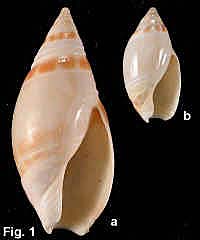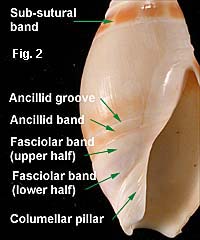

|
Amalda
marginata (Lamarck, 1811)
Description: Shell broad, aperture length between one-half and two-thirds of total shell length.
Spire calloused, callus terminating in front of the aperture;
suture concealed by callus. Spire
whorls smooth or spirally ribbed, ribs ending in front of the aperture.
Body whorl with calloused subsutural band, edged by deep groove below.
Non-calloused part of body whorl with microscopic axial and spiral
striae. Columella pillar
with six plaits; fasciolar band with central ridge, upper and lower
halves both smooth, either flat or rounded; ancillid band narrow,
bordered with a deep groove. Non-calloused area of body whorl off-white;
subsutural band white with axial brown streaks; fasciolar band and
pillar area white, lower half of fasciole occasionally with interrupted
brown patches. Operculum
brown, corneous.
Size:
Up to 50 mm in length.
Distribution: Endemic to
Australia
; Clarence R, NSW,
to
South Australia
, including
Tasmania
.
Habitat:
Subtidal on sand, down to about 80 metres.
Rarely taken alive intertidally in NSW, but common as a beach
shell.
Comparison:
This is the broadest member of the group.
Large southern specimens can be identified easily, as all other
members of the genus are under about 28 mm.
In central and northern NSW the small form of A.
marginata occurs commonly on beaches with A. oblonga, and the two are sometimes quite similar.
A. marginata is always
broader and, in this form, may have brown colouring on the bottom half
of the anterior fasciole only, while oblonga
has brown markings over all the base.
Remarks:
Shells which occur at the northern end of the range are smaller
and show weaker sculpture on the spire. Tasmanian
and South Australian specimens may reach 50 mm in length, and have a
heavily ridged spire, but those taken off
Sydney
do not exceed 35 mm,
and have weak ribbing on the spire. A
small form, under 20 mm in length with weak ribbing on the spire, occurs
commonly around
Sydney
and northwards.
This smaller form was given the subspecific name marginata
dyspetes Iredale, 1936.
Figs. 1a, 2: 5.5 km E
of Long Bay, NSW, in 76 m (C.387847)
Fig. 1b: Wooli, NSW
(C.146716)
|